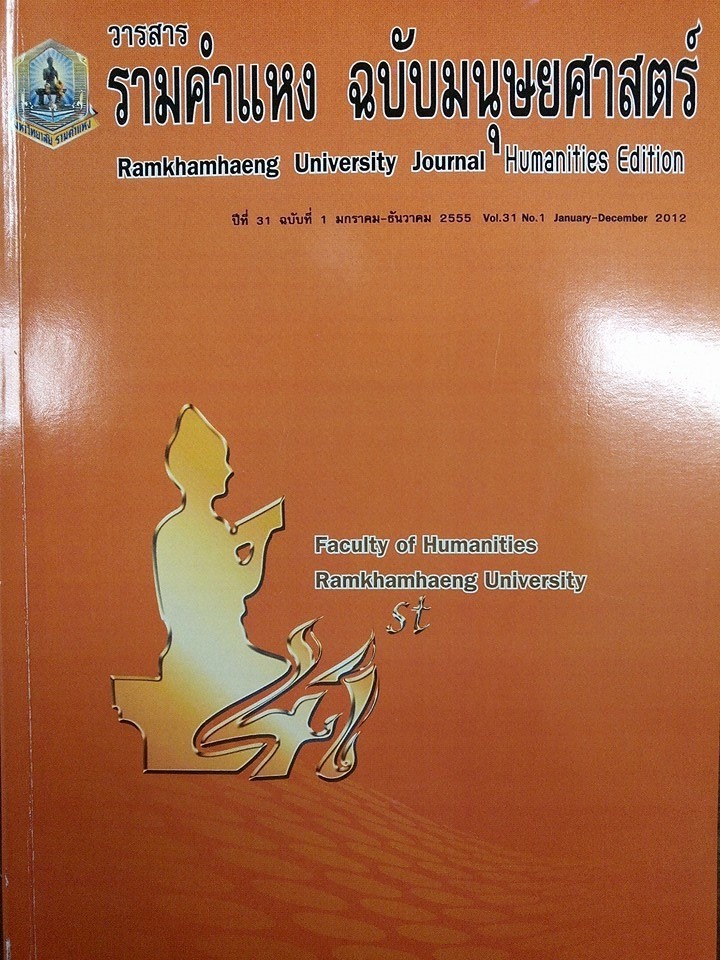Queen Guinevere in the Stanzaic Morte Arthur: The Celtic Heritage of Medieval Women การสืบทอดวัฒนธรรมเคลติคของสตรีสมัยกลาง: กรณีศึกษาพระนางเกวนเนอเวียร์ใ
Main Article Content
บทคัดย่อ
Abstract
This study examines how much of Celtic Iron Age cultural heritage can be found in the depiction of a female, the legendary King Arthur’s wife Guinevere, in a fourteenth century literary text, i.e. the Stanzaic Morte Arthur. First, the roles of a female Celtic aristocrat (warrior, queen, married woman and, possibly, priestess) are described, followed by an analysis of the roles their medieval counterparts were expected to fulfill (religious woman, married woman, queen) using diverse fields of study such as history, art history, (ecclesiastical) law and social studies, but also folklore and mythology. In the second part of the study, the analysis of selected scenes from the Morte Arthur show that Guinevere’s behaviour identifies her as a representative of the Celtic “amour de fée”. Her name (“White Phantom” or “White Illusion”) and colour symbolism connects her with Celtic solar (horse) goddesses as does the mode of punishment for her adultery. The analysis of scenes featuring two other females i.e. the Maiden of Ascolot and Morgan le Fay, reveals Guinevere’s and Arthur’s connection with the Celtic otherworld.
บทคัดย่อ
งานวิจัยนี้มีวัตถุประสงค์เพื่อศึกษาอิทธิพลของมรดกตกทอดทางวัฒนธรรมเคลติค ยุคเหล็กว่ามีปรากฏให้เห็นมากน้อยเพียงใดในวรรณกรรมอังกฤษสมัยคริสต์ศตวรรษที่ 14 โดยศึกษาจากบทพรรณนาถึงสตรีเพศกรณีของพระนางเกวนเนอเวียร์พระมเหสีของกษัตริย์ อาร์เธอร์ ที่ถูกกล่าวขานจนกลายเป็นตำนานผ่านบทร้อยกรองชื่อ Stanzaic Morte Arthur ในขั้นต้นผู้วิจัยอธิบายถึงบทบาทของสตรีชาวเคลท์ในสังคมชั้นสูง (นักรบ ราชินี หญิงมีสามีแล้ว และหญิงที่ครองสมณเพศ) จากนั้นผู้วิจัยวิเคราะห์เทียบบทบาทที่ถูกคาดหวังว่าจะพบในสตรีสมัยกลาง (หญิงเคร่งศาสนา หญิงมีสามีแล้ว ราชินี) โดยใช้วิธีศึกษาจากประวัติศาสตร์ ประวัติศาสตร์ศิลป์ สังคมศาสตร์ บทบัญญัติ (ของศาสนจักร) รวมทั้งคติชาวบ้านและเทพปกรณัม ในส่วนที่สองของงานวิจัยผลการวิเคราะห์ฉากที่คัดเลือกมาจากบทร้อยกรองแสดงให้เห็นถึงพฤติกรรมของ พระนางเกวนเนอเวียร์ที่เผยพระองค์ในฐานะตัวแทนของ “amour de fée” ในวัฒนธรรมเคลติค พระนามของพระองค์ (“ภาพหลอนสีขาว” หรือ “มายาสีขาว”) และสัญลักษณ์สีของพระองค์ ตลอดจนวิธีการลงโทษการประพฤติผิดในกามของพระองค์เชื่อมโยงพระองค์กับเทพธิดา(อาชา)ของชาวเคลท์ที่เกี่ยวพันกับดวงอาทิตย์ นอกจากนี้การวิเคราะห์ฉากที่นำเสนอสตรีอื่นอีก 2 นาง คือ สาวน้อยแห่งแอสโคล็อต และมอร์แกน เลอ เฟย์ ยังชี้ให้เห็นถึงความเชื่อมโยงของพระนางเกวนเนอเวียร์และกษัตริย์อาร์เธอร์กับภพอื่นในวัฒนธรรมเคลติค
Article Details

อนุญาตภายใต้เงื่อนไข Creative Commons Attribution-NonCommercial-NoDerivatives 4.0 International License.
ประกาศลิขสิทธิ์จะปรากฏในเกี่ยวกับวารสาร ควรอธิบายสำหรับผู้อ่านและผู้เขียนว่าเจ้าของลิขสิทธิ์เป็นผู้เขียนวารสารหรือบุคคลที่สาม ควรรวมถึงข้อตกลงการอนุญาตเพิ่มเติม (เช่นใบอนุญาตครีเอทีฟคอมมอนส์) ที่ให้สิทธิ์แก่ผู้อ่าน (ดูตัวอย่าง) และควรให้วิธีการรักษาความปลอดภัยหากจำเป็นสำหรับการใช้เนื้อหาของวารสาร


